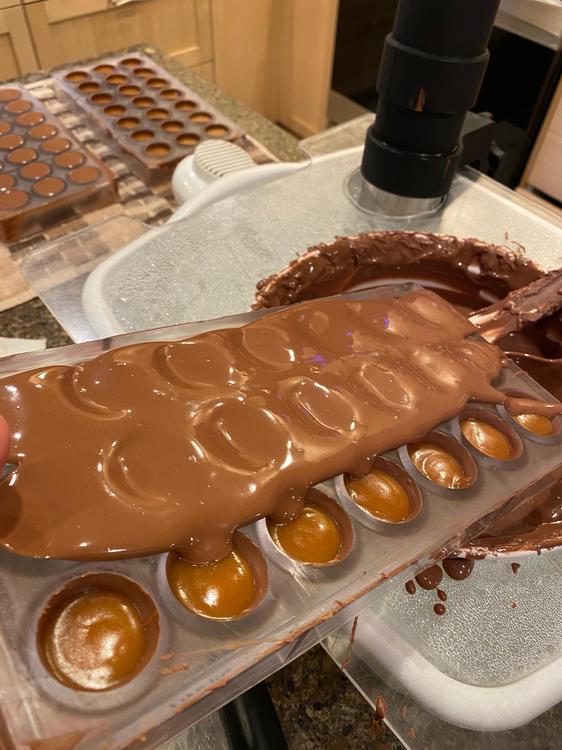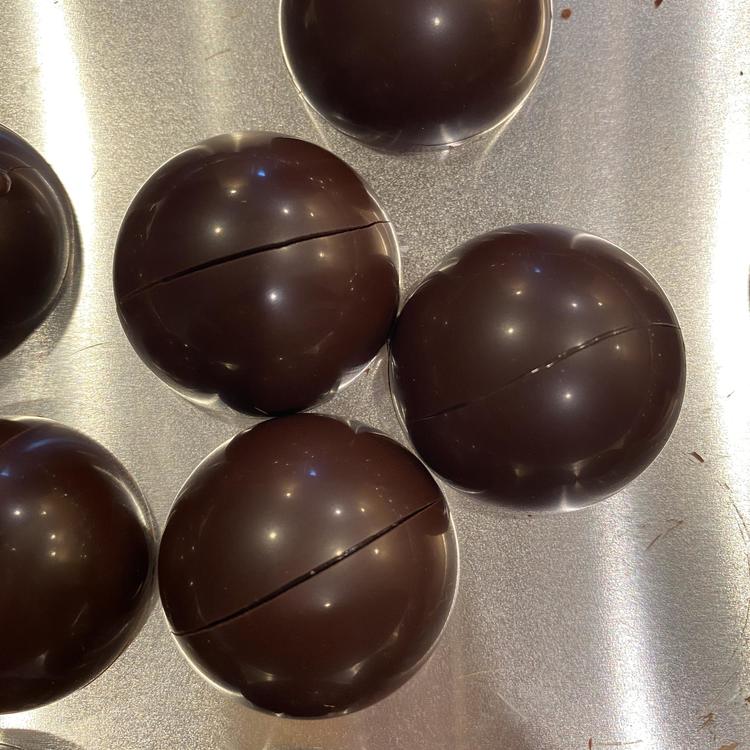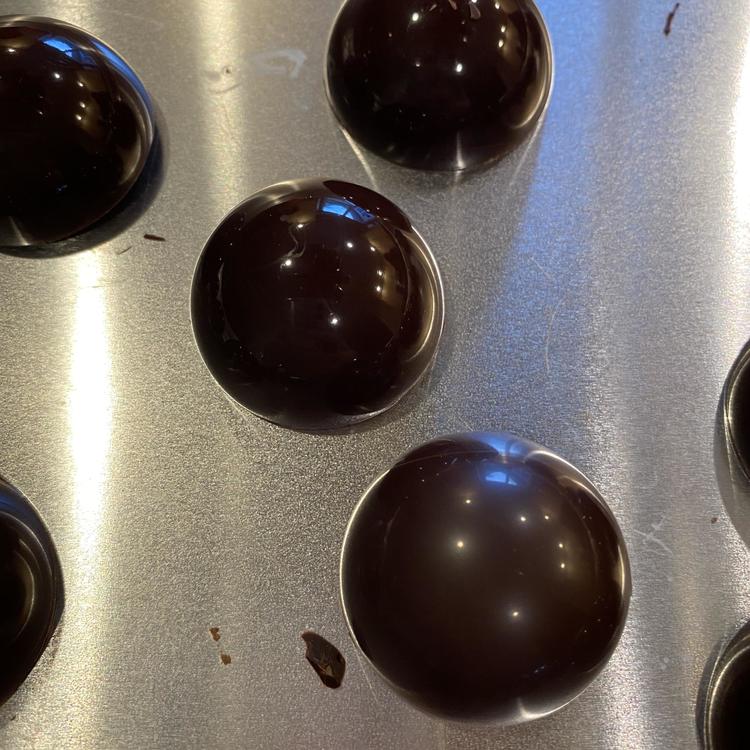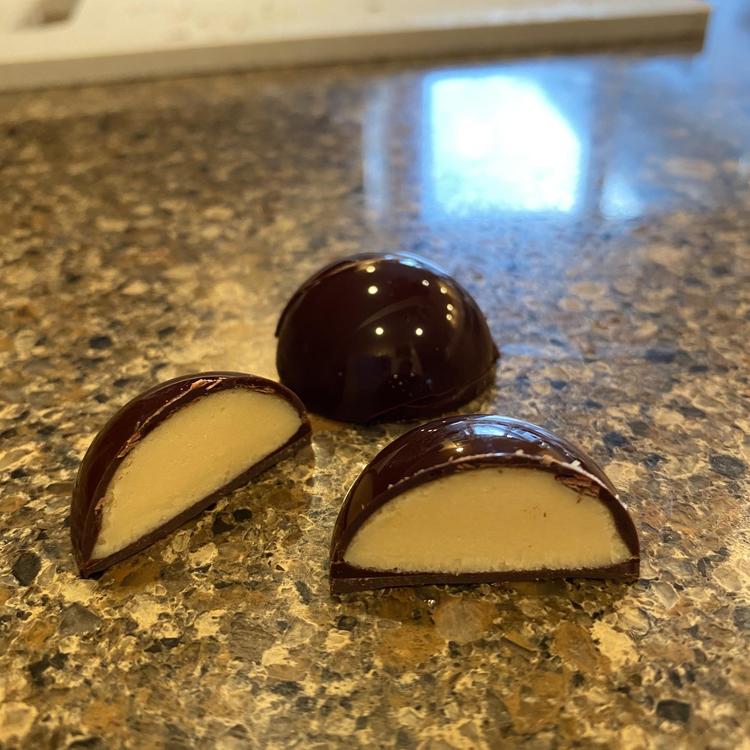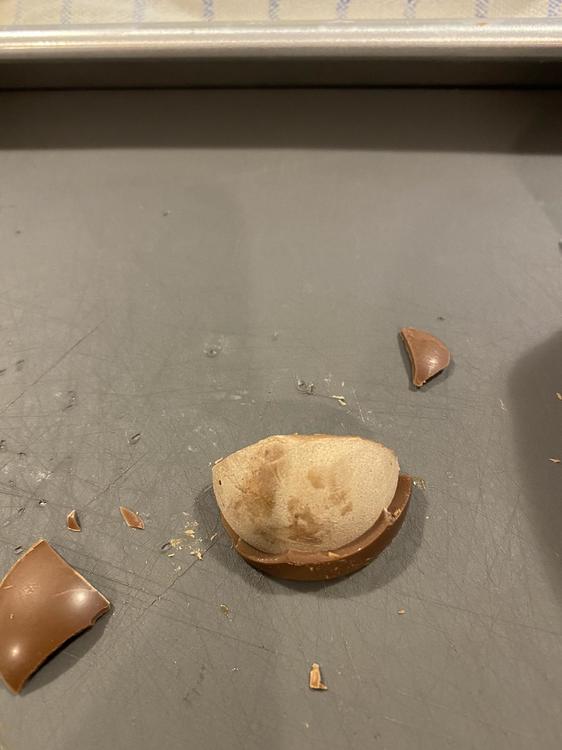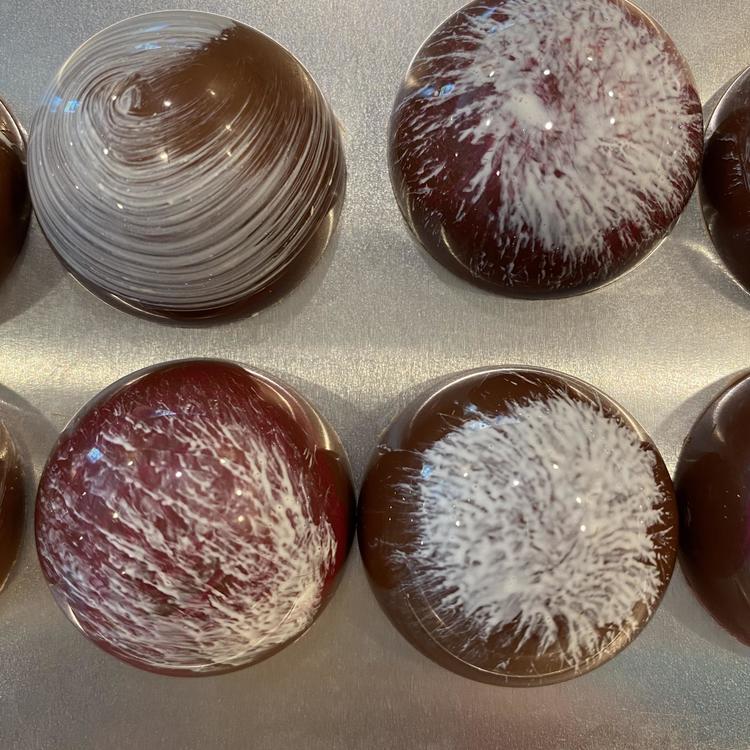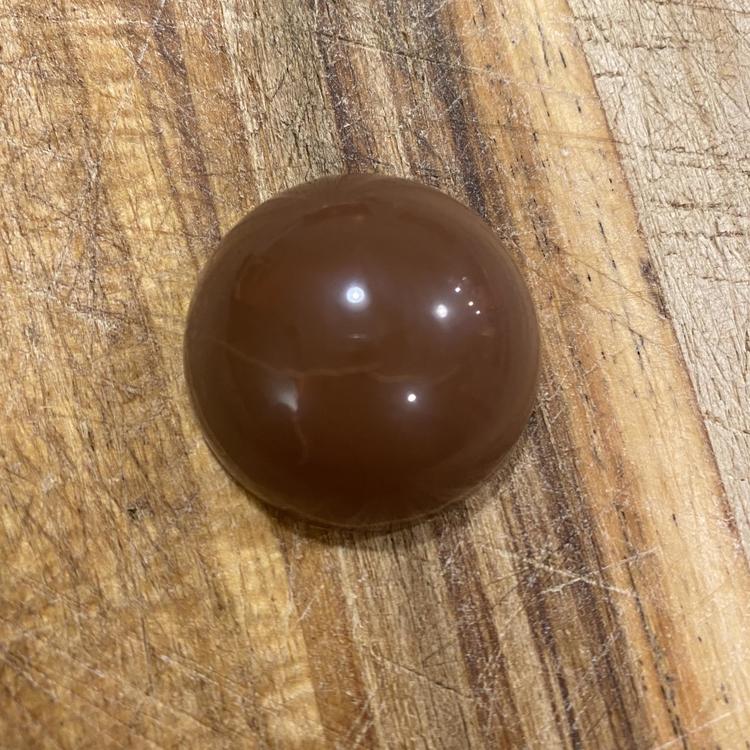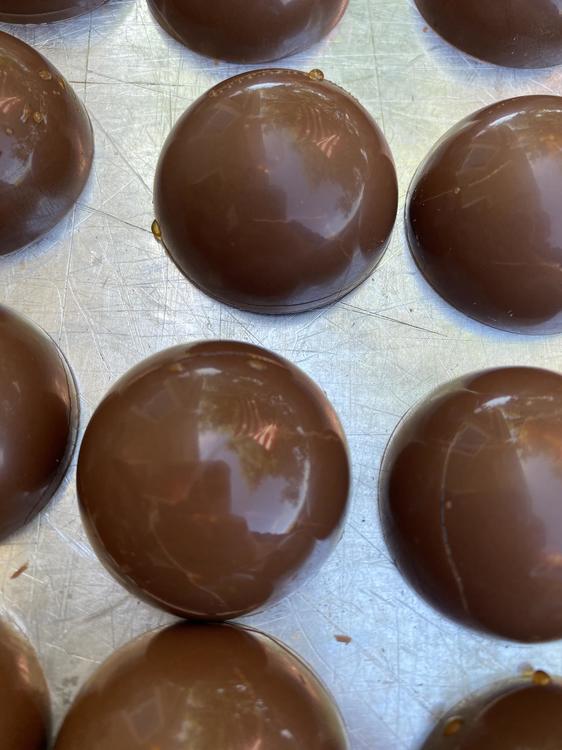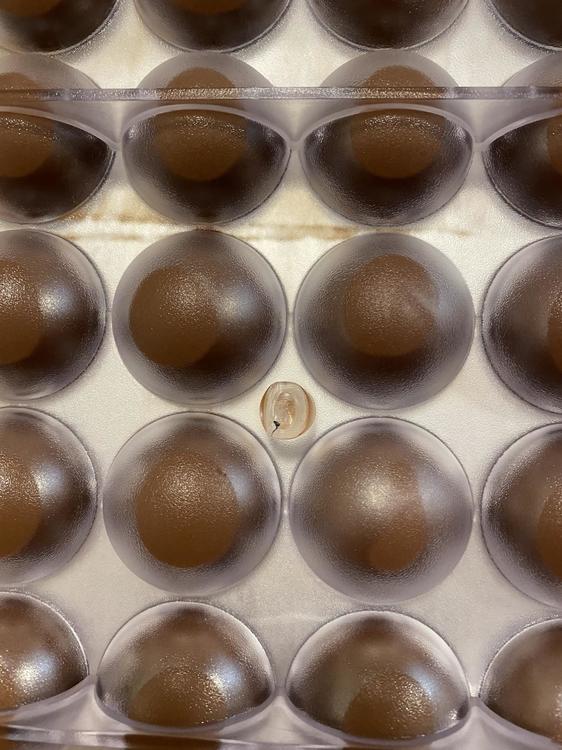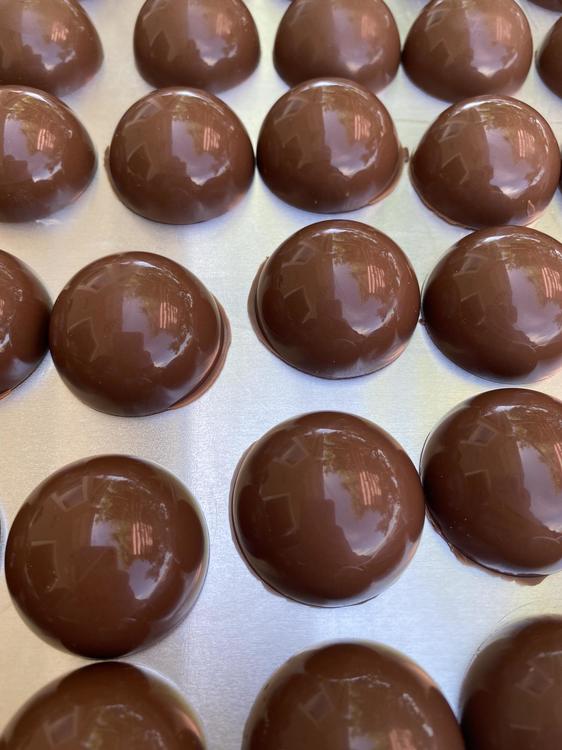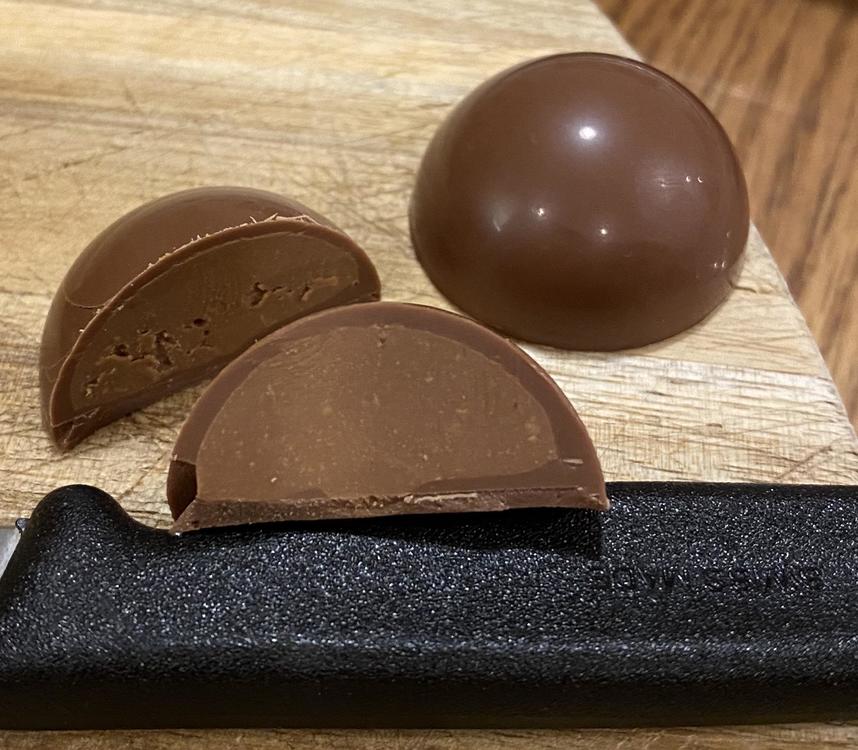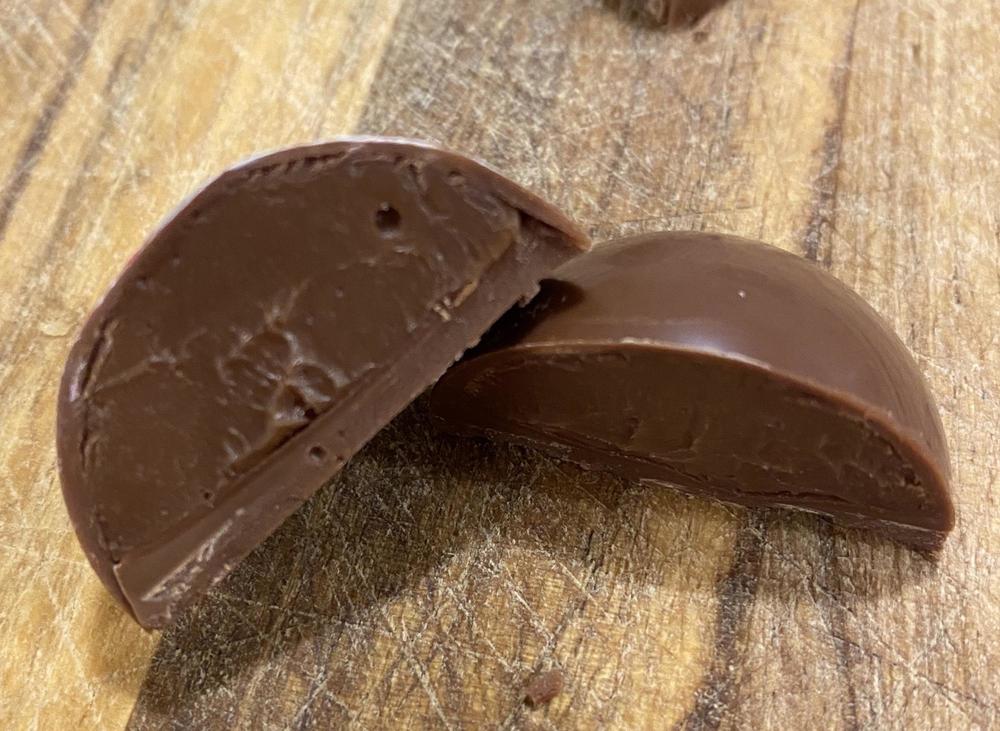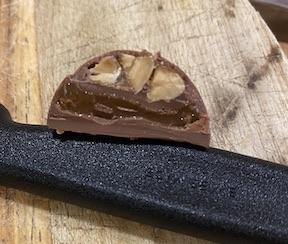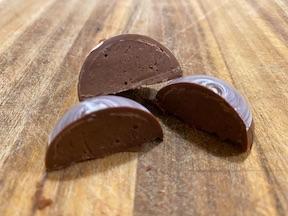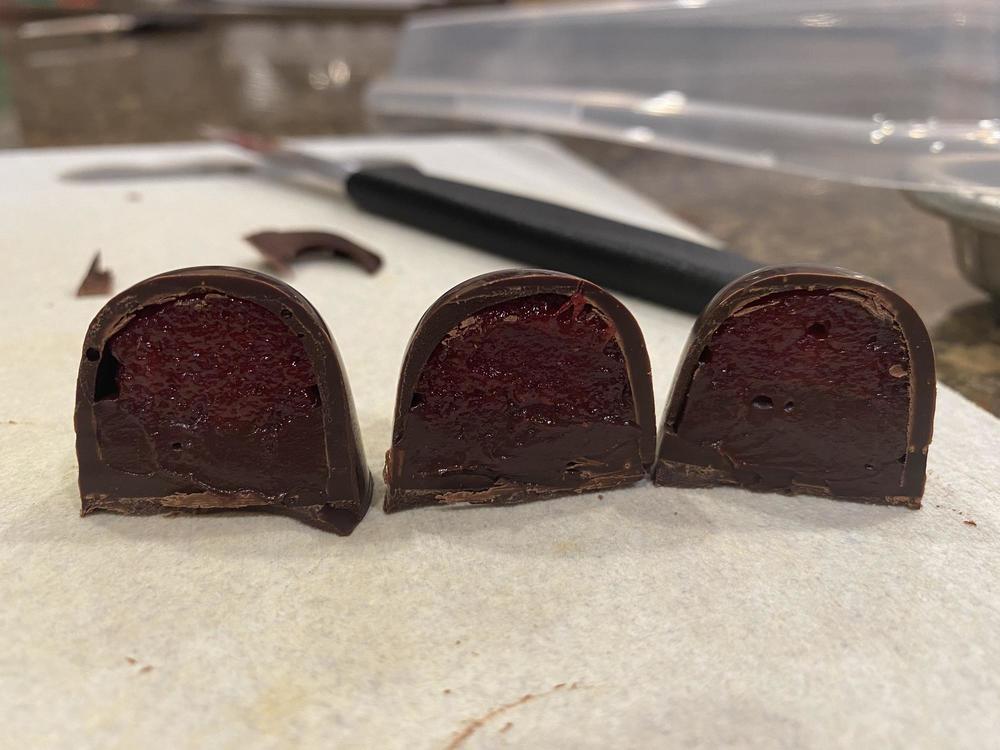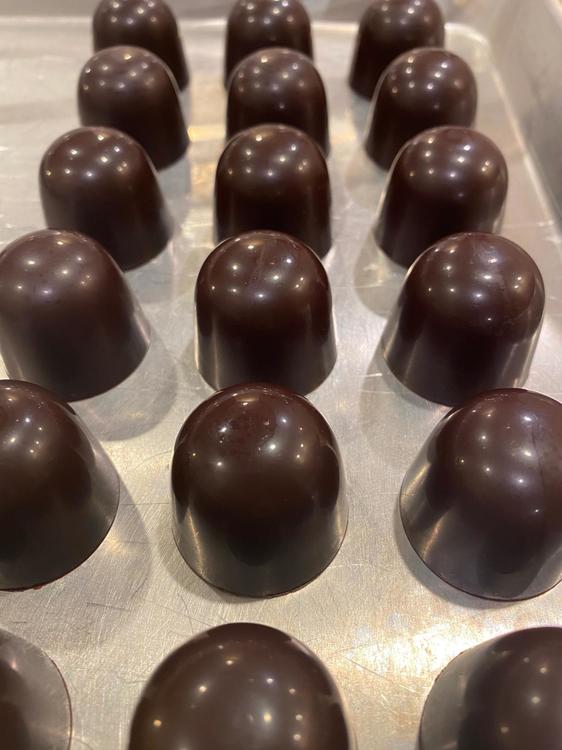-
Posts
196 -
Joined
Content Type
Profiles
Forums
Store
Help Articles
Everything posted by GRiker
-

Molded and Filled Chocolates: Troubleshooting and Techniques
GRiker replied to a topic in Pastry & Baking
We're about 50 minutes South and inland from SF. I guess I'm just comparing it to upstate NY where my husband is from. Now that's humid! -

Molded and Filled Chocolates: Troubleshooting and Techniques
GRiker replied to a topic in Pastry & Baking
I hear two questions here, one is how long should I let the ganache crust? and the second is why does the ganache squeeze out while capping? Now that I am making tempered ganache, I can cap within the hour of filing as the ganache is setting quickly. I believe I've read before that if it's not tempered (like I think you're doing) that you need to let it sit at room temp overnight before capping. Sometimes the ganache will squeeze out while capping if the cavities are filled too full. Also as JimD said, you don't need to wait until room temp to pipe, you can pipe into your cavities when your ganache is at 83F or lower. What kind of chocolate are you using? What molds are you using? -

Molded and Filled Chocolates: Troubleshooting and Techniques
GRiker replied to a topic in Pastry & Baking
Thanks for the kind words. It's been rewarding to see some success. I'd always used the seed method and it took a long time but was successful. When I started reading this forum, I learned about the EZTemper and silk and was very interested in that. Since an EZ Temper doesn't seem cost effective for me yet, I used my sous vide to make some silk and after a couple trys I think I got it right (my cocoa butter needed to be melted out throughly and I needed to start over (thanks Kerry).). While having the liquid silk is great, keeping it at temp to use anytime is not practical for me. So, this is what I did. I created the silk with my sous vide. I used some of that original silk in a project I was making. Then I took the rest of the silk and put it into plastic container to use later. If I need 10g of microplaned silk for 1000g of melted chocolate, I add that microplaned silk at about 93.5F degrees. The temp lowers as it melts. Then I stir for a minute or so, test the temper by putting a dab with a tail (kind of looks like the outline of a Hershey kiss) on a piece of parchment, then stir a bit more. Usually after 3 minutes or so I can see the tail start to "dry" and after a few more minutes the thicker part starts to "dry". I keep it I temper by holding it over a sous vide bath as seen below. The plexiglass top keeps the condensation out of the chocolate but keeps the chocolate at temp. I check the temp of the chocolate periodically to make sure it's good. I usually keep the water bath at say 93F or so when I'm molding since I'm continually adding back in cooled chocolate. That keeps the chocolate below 90F. I much prefer working with dark chocolate over milk, but lots of people like milk (including my family!). Part of the reason I like dark is because it just seems like it tempers faster. I follow the same process for the milk and the dark, but the milk seems to take longer. I thought I was using tempered chocolate when I mixed the cookie butter filling, but it seems that it was totally out of temper. I also wondered about my temper because I had a hard time getting some molds out. From your comments however, it sounds like I piped it too hot and that likely had something to do with the loss of shine and the difficulty unfolding. Thanks for that information. I will definitely use those numbers next time. When I looked just now, my Nest Thermostat says 58%. I'll keep track of that number and see if I can find any correlations there. I haven't kept track of it, or even looked much. In the SF Bay Area where I live it's usually not very humid, but I'll keep an eye on it. Thanks for the 50% note. That will help. -

Molded and Filled Chocolates: Troubleshooting and Techniques
GRiker replied to a topic in Pastry & Baking
I forgot that I did have shine success when I was just practicing with some new molds I bought from @Jim D.. I made a Yuzu Ginger Ganache and Honey Mango with the new molds. The shine was much better. My 10 year old and I made played with colored cocoa butter in 8 hemisphere molds with the mint ganache and the maple pecan mentioned in the previous post. We painted with chocosphere white, then had so much fun we decided to use some pink too. This is the first time I've used colored cocoa butter. To ready it to use, I melted it at 30 second intervals and shook in-between. Once some of it was liquid, I took its temp (90F) and shook a bit more. I then put some into a ramekin and use various methods to try to keep it at temp. We used new paint brushes and had fun with that. Next, I shelled the mold, let sit for about 5 minutes, emptied, and then let sit out for about 5 minutes before putting it in the fridge for 15. Then I filled them with ganache the next day. I capped them soon after. I set them in covered jelly roll pans overnight in the garage where it was cool (60s). The next morning, the maple pecan ones came out easier (after 2 hours in the fridge), but the mint ones required time in the freezer before they would come out. I wondered what the difference was. I decided that I think I piped the mint ganache too warm, I think it was closer to 90F than 86F. Does it make sense that if I piped into a milk shell at close to 90F that the shells would not release as well? Later, I made I made 8 hemisphere molds and 1 dome mold half with cookie butter and half with salted caramel almond in previous post. The dome mold was a layered combo with almonds, cookie butter and caramel. I shelled all the molds in the same evening. Four of the hemisphere molds were plain molds. For these, I following the same process as listed above. For the remaining four hemisphere molds and the dome molds, I shelled a mold, then dropped a few of the prepared almonds inside while the chocolate was still wet. After they set for a few minutes, I put them into the fridge for about 15 minutes. After they were out of the fridge, I used a piping bag to pipe some of my tempered chocolate on top of the almonds to cover them. I made the cookie butter filling, and filled 4 plus one layer in the dome then made the caramel and piped in into the rest. Then I let them sit overnight covered in the garage until morning when I capped them. When I first got these molds from Jim, I practiced shelling with them and got cracks in most of the cavities. I heard some of these happen when I twisted it like an ice cube tray. I decided that was a bad way to get these out? So, I didn't do any twisting while unmolding. However, when I used them to make ganache filled bon bons, I also got these cracks. This last round, I only got one or two. When I went to unmold them, the almond caramel came out without much work. However, their shine was not good and they had little cracks all over them. Any ideas on why I got these cracks? The first were different than I cracks I got with the salted almond. The first cracks were all the way across, these ones were more light lightening. The cookie butter ones looked still stuck to the mold and didn't easily come out. I had to thwack them quite a bit to get them to come out. However, their shine was better. I did notice before I capped them that the temper of the chooclate/cookie butter mix was off. I thought about melted them and re-doing, but since I'm not selling them but giving them away, I decided to just give them away anyway. Here's a picture of them top of the shell of and what the cookie butter mixture looked like. I've been cleaning the molds as described previously but strangely the shine is very different from one mold to the next. I wonder if it might be having more to do with my temperature or humidity as mentioned previously than with my mold cleaning process? I see 65F as being a good temp for chocolate work, but what percentage humidity? I'm also wondering if my tempering skills need improvement if I need to thwack the mold so hard to get the chocolates out? Is there anything you see that points in that direction? I'd really like to take a class with a professional to measure my skills, but not sure when that can happen. I had planned to go to LA to take a class on molded bon bons with Ewald Notter that Guittard was hosting, but it just got postponed. 🙁 -

Molded and Filled Chocolates: Troubleshooting and Techniques
GRiker replied to a topic in Pastry & Baking
Thanks for all your tips. I'm working to make sure the cavities of my molds are clean. Sounds like there are all kinds of ways to do that, for now I"m sticking with the vodka and make up pads since that's what I have. When I run out of that, I may try some rubbing alcohol (maybe by then I'll be able to find some!) @gfron1, yes! I do see how shiny the red is in your picture when compared to the others (though they are all beautiful!). @teonzo and @Kerry Beal, I worked quickly to pipe my ganache while it was still crystallizing when working with tempered ganache. I filled 4 molds of 24 cavities each and could feel the ganache thickening over time. Usually I sell some chocolates to friends at Mother's Day but have decided not to do that this year and am using my couverture chocolate from Guittard to practice bon bons. Not surprising, I've found that the right chocolate really makes a big difference. What I had been using for hand dipping does not work very well for molded bon bons. These bon bons are all made with Soleil d'Or Collection Etienne Guittard Chocolate. I've made several new bon bons over the past month. I'm in the process of making surprise deliveries to friends to spread chocolate cheer! It's been a good way for me to practice but not have to eat them all. Speculoos cookie filled - 50% Milk - Guittard Soleil d'Or and 50% Trader Joes Speculoos Cookie Butter as suggested here. People liked these. While the taste was delicious, I thought the end result was a bit too firm. Next time I'll do 60% cookie butter, 40% chocolate and see how that works. I know I could also try using it in a ganache, maybe I'll do that another time . Fresh Garden Mint Ganache. I used the standard milk filling ganache from Notter's Art of Chocolate. Then I added 25% of the volume of cream in corn syrup and 10% of the total recipe in unsalted softened butter. I steeped 8 g of fresh mint in the cream. I loved the texture of the ganache, but the flavor was super strong. They taste better a week out, but next time I'd either use a mint oil or less fresh mint. . Salted Caramel Praline - Notter. I really liked this Bon Bon. I combined salt and egg white with almonds and roasted them. Then dropped them into the still wet shell. I put them in the fridge for about 15 minutes, then covered them with as little tempered milk chocolate as possible. After they were set, I piped in some caramel and let it set over night and then capped them. Next time I'll chop the nuts smaller. Maple Pecan Praline - Notter. This is made with real maple syrup and toasted ground pecans. I processed the pecans in the food processor by themselves. After a bit, they'd just stick to the sides. I scraped them off a couple times, but they didn't get too much smoother. I might try processing the pecans with the chocolate or using an immersion blender when I add them in (sounds like the immersion blender would be easier, so I'll probably try that next.) The filling was not very smooth when I first made it, but over a couple of days sitting in the bon bons it has gotten better. I thought the filling without the pecans, as a maple ganache was also delicious! I had a few problems which I'll post next. -
If I take the batch size of 1650g minus the existing ingredients, I would try 955 g? I haven’t made it, but if I were to make it, I’d give that a try. I see to make cut pralines, he says to use 1100g, so the right direction anyway.
-
Maybe we’re on the same email list! I saw them this week and saved the recipe to try sometime. They look delicious.
-

I demolded ch. pralines and want repeat. What to do in between?
GRiker replied to a topic in Pastry & Baking
I’m afraid there is no simple answer. There are lots of personal preferences and no one answer. I’m new as well and read through many posts about polishing/not polishing. It might help to make a list of the different recommendations and then give the ones you’re most interested in a try and see what happens. -

Molded and Filled Chocolates: Troubleshooting and Techniques
GRiker replied to a topic in Pastry & Baking
You're right that I didn't get the polish I was looking for, certainly not the kind of polish I've been seeing around here! To recap, one suggestion is that I use the cotton balls over cosmetic pads. Melissa uses one cotton ball per cavity. You use two per three (only slightly less frugal I'll note! 😉). When I polished mine tonight, using one cosmetic pad per row (3 cavities), I couldn't believe how many I had for the trash can when I was finished. Then with those cotton balls, polish few cavities per ball - as few as my frugality will let me! After that, you polish with a very clean, dry microfiber cloth - no alcohol? Have you tried the Costco Microfiber cloths? https://www.costco.com/kirkland-signature-ultra-plush-microfiber-towel%2C-yellow%2C-16-in-x-16-in%2C-36-count.product.100356999.html How/Where do you store your molds until you use them? You polish them well ahead of using them right? As for the alcohol vs. vodka. Are you using 91% or 70% isopropyl, IPA? I guess I wonder what that other % is and is it food safe... I did think last week that maybe I'd give it a try, but alas no IPA to be found anywhere. Sounds like you don't have any concerns about that... Thanks so much for the input. I really appreciate your suggestions. -

Molded and Filled Chocolates: Troubleshooting and Techniques
GRiker replied to a topic in Pastry & Baking
Not for that reason - no. Some of those posted bonbons did have a few little droplets on the bottom after a while. If it's not because I didn't heat them before I sealed them, I wonder why? too full before sealing? -
I'll definitely work on getting the ganache thinner, perhaps with a milk or white ganache and piping it while quite thin - working faster before it crystallizes. Also using some of those methods to thin the PdF. Thanks for those suggestions. @Pastrypastmidnight Would you mind sharing what's on the bottom of the bonbon you posted? And marshmellow - I definitely want to try marshmallow!
-
My husband usually takes my practice pieces to his work, but alas now he's working from home. This might be my opportunity to try to freezing techniques!
-
For sure! And if it's two bite bonbon, it doesn't keep its shape anyway. I'll try that next time. Thanks. Thanks. Would you be concerned about the air bubbles that you see?
-

Molded and Filled Chocolates: Troubleshooting and Techniques
GRiker replied to a topic in Pastry & Baking
So you don't find that more liquid fillings leak? -

Molded and Filled Chocolates: Troubleshooting and Techniques
GRiker replied to a topic in Pastry & Baking
Thank you! I'll do that next time. -
These sounds like good ideas too. I'm going to put them on my list of things to try. Thanks!
-
Today I didn't feel like juicing my own oranges, and I didn't have any juice on hand, so I used Perfect Puree Corazon concentrate (blood orange, pomegranate and passion fruit). I used 165g and reduced it to 100 - 110 grams. The resulting ganache was thicker than when I used the orange juice. It didn't self level as before. Really since concentrate is already reduced, I probably should have just used 100 - 110 grams of the concentrate and boiled it with the cream without reducing it.
-
I working on this today after some study on the PdF board and acquiring the pectin and sorbitol. I used 1/4 of your recipe here: I found that the result was thin enough to pipe and flowed much better so that I didn't feel like I was trapping so much air between the raspberry and the shell - my last attempts definitely trapped lots of air. When I cut them open, I see there was still at least one spot where things didn't flow as nicely. I did still have the issue with little peaks after piping it into the shell with a piping bag. I ended up squishing them down with a cornstarch covered finger but that was time consuming. If I'm still getting the peaks and it's not quite as flowing as I like, does that mean I might need to add a bit more water, or maybe just improve my piping techniques? I decided to use the Perfect Puree as if it were a completely pure puree. Doing some poking around the forums, it sounds like the ingredients added are simply to ensure a uniform product even when the fruit is varying with the season/harvest etc. The taste is nice. Not too sweet. Thank you for the pointers and suggestions.
-

Molded and Filled Chocolates: Troubleshooting and Techniques
GRiker replied to a topic in Pastry & Baking
I realize this is an older thread, but in preparation for actually working with chocolate today, I've been doing a lot of reading and read through this whole thread as well as some others. Thank you to all here who asked and answered questions. I had good success today on take 3 or 4 of doing molded chocolates thanks to what I learned here. I have some dome polycarbonate Chocolate World molds. This is what I did after gleaning from all the shared knowledge here. When I got the used molds, I washed them in hot soapy water in my sink. The next times I used them, I've just rinsed them using hot water, at the end of today's batch, I heated them up and rubbed off the excess chocolate with a soft towel. I think heating and wiping off is the process I will follow as long as things don't get too messy. After I polish them, I will store them face down in a box in an attempt to not get dust on them until I am ready to use them again. I polished my molds using vodka and some cotton make up removal pads. In previous attempts I polished with a clean soft cotton cloth, but found that the next time I used them I got little spots on the chocolates. I also understand some use 91% isopropyl, but went with the vodka option. I tempered my chocolate using some silk trying to keep the chocolate as hot as possible while still staying in temper. I don't have A/C, but it was a moderate day in the Bay Area, so the house about 68- 70. I set my bowl of chocolate over a water bath kept at temperature with a sous vide and an acrylic top to keep the water and its vapor out of the chocolate. I did not warm my molds before filling. I had 4 molds to fill. I filled them each with a small metal ladle. As experience and reading here has taught me, I tried to use as little chocolate as possible to completely fill so that I didn't have so much to wipe off. I tapped my filled mold on the counter and also tapped on the sides of the mold with my taping knife to get the bubbles up through the chocolates to the surface. I am not using the ideal chocolate for molding, but it's what I have and since I have quite a bit of it, I will use it up then get the proper couverture. I also hand dip chocolates and the chocolate I have works well for that, not as well for molding. I filled one mold at a time. Once I had tapped out the bubbles, I scraped across the top with my newly acquired stainless steel taping knife from Home Depot. This knife worked better than the dough pastry scraper I had been using. I held the knife at between 45 and 80 degrees or so and tried to take off as much as possible in one pass. I scraped off the sides carefully as the knife is pretty sharp and it wasn't as easy to scrape smoothly in that direction. I did one more pass with the knife across the top to make sure it was clean. I varied how long I let the chocolate sit in the molds. The shortest was about a minute, just waiting and then dumping it back into my chocolate bowl. Longest was to set it down, fill the next one then empty the first into the bowl. The ones that sit longer had a tendency to have a harder time emptying and left a lip of sorts close to the edge. Once I also turned one mold over and set the mold corners on the edges of a jelly roll pan to let it drain. That left a lip too. After the shells were emptied, I again scraped the top with my taping knife. They scraped clean nicely. Once the shells exhibited the matte finish that shows they are beginning to crystallize, I put each tray into my household fridge, at 43F, 6C - I know it's a bit cold but it's what I've got! I left them for about 15 - 30 minutes or until I could see that all or most of the shells had released. This is the first time I put my shells into the fridge. On this forum several of you said this is what you do. In addition, the recommendation came from Michael at Michael's Chocolates in SF whom I met the the Chocolate Craft Experience and who was generous with his time and help. While the shells came back to room temp, I made my fillings, a raspberry pate de fruit of sorts and a Corazon ganache (blood orange, pomegranate and passion fruit.) I filled my shells when the filling was about 85 - 88F. My first layer in was raspberry, then the ganache. I tempered my ganache using silk but couldn't remember how long people had waiting before capping. I knew that you can cap sooner if the ganache is tempered, just couldn't remember how long. I decided to wait about an hour. The ganache had clearly begun to set so I decided it was good enough. To cap, I sparingly covered the ganache with tempered warm chocolate (I know I should have warmed the shells first with my hair dryer, but I forgot - next time!). I tapped on the molds as before to help get rid of air bubbles, then scraped off with the taping knife. I tried to minimize the number of passes as the bottoms actually seem to get worse with more passes. Usually no more than two passes. If I had a hole in the bottom, I used my spatula to put a small dollop of chocolate on it. I read about using acetate sheets for nice shiny bottoms, but I didn't have any, though I do have some sheet protectors like @Jim D. used, decided against using them for now. Once the bottoms started to crystallize, just a couple minutes later, I popped them in the fridge for 15 minutes or so. I let them come up to temperature for 30 minutes or so, then demolded them onto a jelly roll pan. Indeed, hearing them all fall out onto the pan was music to my ears as in the past lots of banging and even freezing was required to coax them out. If you bang too hard on your molds, they will crack! This time all four trays came out pretty cleanly. I did need to do a gentle tap a couple times, but not more than I think is expected. The chocolates are not perfect, I see some lines across the tops of a few of them and they're not as shiny as I wish they were, but my best so far. I also have some that are leaking, but not surprising as I forgot to heat the shells before capping. Thanks again for all the questions and answers posted here. I was reminded today about the quote I saw here "if it were easy, anyone could do it." It's not easy but it sure it fun and satisfying when it works. -

EZtemper - The Help You Need to Achieve Perfectly Tempered Chocolate FAST!
GRiker replied to a topic in Pastry & Baking
I saw this on the silk that I made too. I had been talking with a local chocolatier about why I might be having mold release issues. She suggested it was likely my temper - or lack thereof. When I tested my temper, it looked pretty good, but I wondered if my lumpy silk wasn't giving me as good a temper as I might need. So, I used the suggestion to completely melt out the cocoa butter, let it solidify at room temperature and remelt to silk. Once I did that I got a more mayonnaise like consistency talked about here. At 92.5F, 33.6C, it was a bit thinner than mayonnaise, but a nice smooth consistency. I used it today and it seemed to work well. -

EZtemper - The Help You Need to Achieve Perfectly Tempered Chocolate FAST!
GRiker replied to a topic in Pastry & Baking
Yes! Did see him at the Craft Chocolate Experience and the nice looking cocoa pod molds. Despite the health considerations, I think there was a descent turn out. My husband and I really enjoyed it. -

PLANNING: eGullet Chocolate and Confectionery Workshop 2020
GRiker replied to a topic in Pastry & Baking
Everytime I read about the workshop, I wish I could come! This year is out for me, but can someone answer some questions for me? Seems like the location of the workshop changes as I’ve seen postings from years past from different areas. Is there some kind is schedule? When are the dates decided for the next year? Generally what is the cost to attend? I think I saw somewhere that there is a basic fee then an additional masters class fee for those who want to participate in that. I’m doing a lot of reading and learning from the forum - its so helpful. I’m in a stage where I don’t have lots of time to actually experiment but I’m moving along slowly but surely. I’d love to add a future workshop to my plans. -
I don't strain out the zest.
-

EZtemper - The Help You Need to Achieve Perfectly Tempered Chocolate FAST!
GRiker replied to a topic in Pastry & Baking
Yes on Saturday. I saw EZTemper on the presenter list. Are you going to be there? -
Thus the question...how do you really know you've inverted all the sugar when you're doing in at home? And your answer that you can't really know. Good point. Thanks for that insight.



